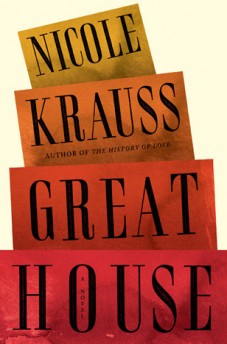 Reviewed:
Reviewed:
Great House by Nicole Krauss
Norton, 289 pp., $24.95
The premise of Nicole Krauss’ highly anticipated third novel, Great House, is elegant in its simplicity: four stories connected by one object. The object is a writing desk — at turns inspiring and ominous — which has occupied cramped quarters in New York, Jerusalem, London, and Budapest. Imbued with the experiences, imaginings, failures, and losses of each of the people who have sat and worked at it, the desk is seen by one of Krauss’ five narrators as a “grotesque, threatening monster,” yet symbolizes “a kind of guiding if mysterious order” for another. It is an imposing piece, intrinsically metaphorical, and described as having “[n]ineteen drawers of varying size, some below the desktop and some above, whose mundane occupations (stamps here, paper clips there) hid a far more complex design…”
The desk has an autonomy and character of its own, but it doesn’t actually occupy much space in Great House. Krauss uses it as a point of departure — or sometimes a point of return — in the four stories that comprise the novel. While these tales are loosely connected by the desk, they run parallel more than they intersect, dipping in and out of the lives of powerfully voiced individuals. Krauss is virtuosic in her ability to create characters, to make idiosyncratic and completely unique lives for her cast: an isolated, desperate American author named Nadia; an embittered Israeli father writing unanswered letters to his estranged son; a widower discovering unimagined secrets about the reticent wife with whom he spent most of his life; and an antiques dealer who specializes in seeking objects confiscated from their owners during World War II. Each individual has his or her own speech pattern and quirky turns of phrase, which Krauss artfully juggles throughout.
Her skill with language extends to evocative images. She describes a son’s voice “unraveling like a ribbon dropped from a roof” as he plans the details of his mother’s funeral. The reader walks with her through a maze-like castle, winding down dark corridors and up twisting staircases until arriving in the drafty turret room of a young boy, “one of those animal burrows one finds in children’s books . . . only instead of descending down under the earth we had ascended into the sky.” Through the eyes of another character, we’re shown an “enormous, vaulted room” in Jerusalem where a grand piano is “hanging from the ceiling in place of a chandelier,” swaying just slightly. On occasion, Krauss’ evocative descriptions feel a bit over-determined and forced, such as in a passage where a man’s sadness “seeped out of him . . . blooming into the atmosphere the way the water around a harpooned seal fills with a cloud of blood.” But in most passages, her mastery of language — of rhythmic, descriptive speech — is stunning.
It’s somewhat disappointing, then, that the promise of the novel’s beginning falls short as the plot lines begin to converge in the second half. As characters from one story encounter those from another, as secrets are revealed and explanations offered, the result is anticlimactic. According to Krauss, in a recent interview with the Atlantic, she “…didn’t want to write a novel with any kind of easy connective tissue. I wanted to, in fact, do the opposite. I wanted to see how long I could hold these stories at a distance from each other so that the connections wouldn’t necessarily happen with easy plot choices.” This may be an admirable approach, eschewing the sort of artificially resonant last-minute links that can undercut an otherwise strong piece of fiction. But while each of the stories in Great House feels meaningful on its own, the connections between them continue to feel arbitrary in the end. Krauss connects her characters through the desk. More pointedly, they are similar in their loneliness, their isolation, and the looming specters of their memories. But aren’t most strangers?
Larissa Kyzer works at New York University and is a second-year master’s student in the Palmer School of Library and Information Science. She is a contributing book reviewer for The L Magazine, Three Percent, and Reviewing the Evidence.

